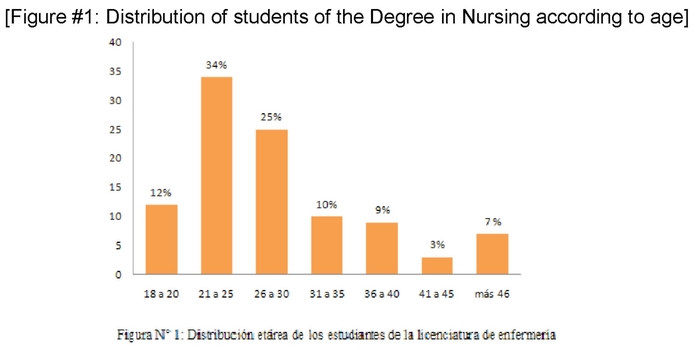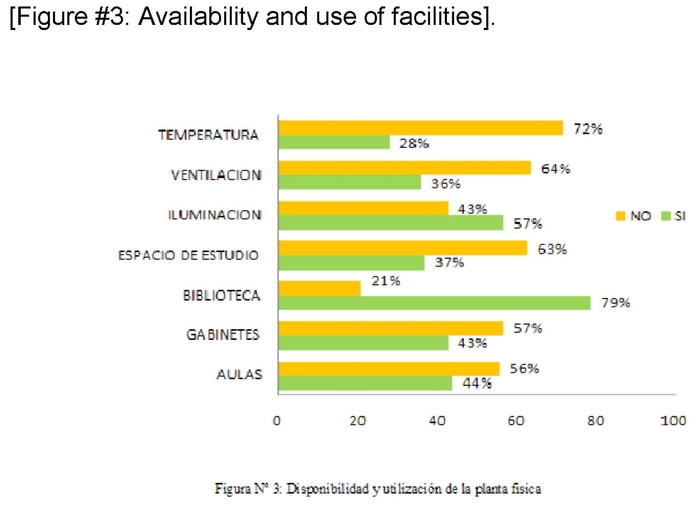Meu SciELO
Serviços Personalizados
Journal
Artigo
Indicadores
-
 Citado por SciELO
Citado por SciELO -
 Acessos
Acessos
Links relacionados
-
 Citado por Google
Citado por Google -
 Similares em
SciELO
Similares em
SciELO -
 Similares em Google
Similares em Google
Compartilhar
Enfermería Global
versão On-line ISSN 1695-6141
Enferm. glob. vol.14 no.38 Murcia Abr. 2015
DOCENCIA E INVESTIGACIÓN
Healthy educational settings and their correlation with academic performance of nursing students
Entornos educativos saludables de los estudiantes universitarios de enfermería
Gómez, Patricia Fabiana*; Cometto, María Cristina**; Cerino, Sandra***
*Chair in Mental Health and Psychiatry. E-mail: patriciafabianag@gmail.com
**Chair High Risk
***Chair in Mental Health and Psychiatry. School of Nursing, Faculty of Medical Sciences, National University of Córdoba. Argentina.
ABSTRACT
Introduction: This research aimed to determine the study and learning environments that have nursing students of the National University of Córdoba.
Methods: Observational - analytical study, period 2011 Universe all students pursuing the degree. Sample stratified random. Technical self-administered survey. Primary source.
Results: The population consisted of 290 students studying different subjects of the degree. 46% of students have between 18 and 25 years, 44 % between 26 and 40; 83% female; 68 % were single; 76% live with family, and 69% have dependents; 56% work and 44% receive help from parents or scholarship.
When analyzing the environment in the organization and management dimension, in facilitating learning materials in-house services discipline highlights its availability in more than 70%. In the variable physical plant over 50% responded that it is not appropriate. Students are supported in their different pedagogical variations in values higher than 75 % As formulation processes complaints, 75% responded that their claims are not heard: by managers in planning Chairs respondents 78% do not exists a negative impact on all the subdomains. 52% of respondents said that driving during the study period shows no ability to manage. Regarding the aspect linking academic students do not feel heard in the institution by 65 %, responding to peer communication is low and intermediate collaboratively by 59 %. 78% of students say there is no communication between the two last ciclos. Por dimension to student participation in relation to the center 92% of students said they are not actively engaged and 59% say they do not promote a healthy environment.
Conclusion: The organization and management, and communication are negatively identified. We consider remaining design elements that illustrate this problem as central to the politics of academic management, to build joint resolution strategies.
Key words: healthy environment; academic performance; Nursing.
RESUMEN
Introducción: La presente investigación tuvo como objetivo determinar los entornos de estudio y aprendizaje que poseen los estudiantes de enfermería de la Universidad Nacional de Córdoba.
Material y método: Estudio observacional-analítico, período 2011. Universo, estudiantes que cursan la licenciatura. Muestra estratificada, aleatoria. Técnica encuesta auto administrada. Fuente primaria.
Resultados: La población estuvo compuesta por 290 alumnos, el 46% poseen entre 18 y 25 años, el 44% entre 26 y 40; 83% mujeres; 68% solteros; el 76% convive con la familia, y el 69% posee familiares a cargo; el 56% trabaja y el 44% recibe ayuda de los padres o beca.
Al analizar el entorno en la dimensión organización y gestión, en la facilitación de materiales, se destaca su disponibilidad en más del 70%. En la planta física el 50% respondieron que no es adecuada. Los alumnos reciben apoyo en sus distintas variantes pedagógicas un 75%. En la planificación de cátedras el 78% que no existe. El 52% respondió que la conducción en el período estudiado no demuestra habilidad para la gestión. Con respecto al aspecto vincular académico los estudiantes no se sienten escuchados en la institución en un 65%, respondiendo que la comunicación entre pares es poco o medianamente colaborativa en un 59%. El 78% de los estudiantes afirman que no existe comunicación entre los dos ciclos. Por último a la dimensión de la participación estudiantil en relación al centro de estudiantes el 92% respondieron que no participan activamente y el 59% afirman que no promueve un entorno saludable.
Conclusión: La organización y gestión, y la comunicación son identificadas negativamente. Consideramos que resta diseñar elementos que visibilicen esta problemática como central en la política de gestión académica, para construir estrategias conjuntas de resolución.
Palabras clave: entorno saludable; rendimiento académico; enfermería.
Introduction
Considering the document from the International Council of Nurses (ICN) about healthy environments and their impact on care quality, as well as WHO's recommendations on health promotion in the educational setting; followed by the dissemination of different studies and recommendations on the topic, we present this article with the first approaches concerning healthy educational settings to relate it later to academic performance1,2.
The relevance of the topic is centered on the concern about the influence the setting represents regarding the commitment of nurses to the institution. There is evidence stating that a negative setting contributes to break the psychological agreement between employer and employee and, as a result, affects the quality of the result. On the other side, different authors agree on the fact that a healthy work setting is a context of professional practice which promotes nurses' health and wellbeing, the quality of patient care and the organization's results. A healthy work setting is essential, not only to achieve workers' health but also as a positive input to productivity, work motivation, work spirit, work satisfaction and quality. 3,4,5
The world crisis of nurse human resources characterized mainly by the shortage of nurses, shows that the causes of this situation are different and complicated, among them we find the not very healthy work settings.6
In the study of the ICN about the crisis of nurse human resources, positive settings for practice and organization results were among the five world priorities for action. The American Academy of Nursing identified that in those hospitals where nurses pointed positively, presented smaller rates of exhaustion, more work satisfaction and better results with patients7. In that study those hospitals were called Model Hospitals. Their characteristics can be applied to all work settings, also to nurse training centers, because they will not only allow retaining students in educational centers but also learning which are the healthy characteristics they should defend and build in future work places. 8
Different studies recommend certain characteristics in order to evaluate favorable settings and professional practice such as: innovative general policy frameworks, centered on hiring and retaining; strategies for continuous training and professional improvement; adequate compensation; merit programs; enough equipment and supplies and a safe work setting 9 In this sense, and referring to the training stage of nurses, that is to say the period of professional studies, interest regarding healthy study settings and their relation to academic performance arises within this research team. The prevailing characteristics shared by study and work settings are: quality, high retention rates, qualified and experienced staff, flexible or alternative timetables allowing a bigger correspondence between the person's needs and the institution's offer. An example of them is the organization of the course of studies in different class shifts, taking into account the high number of students who work.
As regard the educational places, evidence supports the importance of this setting to generate and support health promotion actions which turn them into healthy settings. In this respect, the Colombian experience is quite significant, defining that: "The Healthy University should train creative, self confident, discerning and innovative persons and must create values of self-esteem, self-appreciation, assertiveness, and expression of feelings which will allow students to face with confidence the pressures from the social environment and increase the productive capacity and spiritual growth, the ability to love, play, enjoy, interact with others, integrate, grow together and build citizenship. It should educate independent people, respectful of human rights. Besides, it must shape a new teacher, able to produce knowledge and innovations in the educational and pedagogical fields, create pleasant conditions for self-study and self-learning, and make it possible to acquire knowledge in a democratic, caring setting encouraging self-esteem".10,11,12
Different theoretical and empirical studies13,14, have indicated that school failure and its consequent shattering, do not have only one cause, not even a clearly defined set of causes acting in a known way, but the hypothetic causes seem to vary according to the context of the study. However, the review of the main investigations allows the identification of the following categories: Organizational factors, personal and family factors and contextual factors 15,16
It is important to notice the validity of health policies to foster healthy educational settings in a framework of a health promotion approach, fostering environmental security, pedagogic innovation and personal growth factors allowing the development of skills and abilities to understand and transform reality.
Considering the previous discussion and the correlation between healthy setting and educational setting; for the first part of the research it was decided to get to know the findings regarding the organizational factor; descriptive study including students from the five years of the Degree in Nursing, National University of Cordoba. The dimensions studied were: management, bonding aspect and student participation 17
Recent studies have admitted the increase of failures in academic performance of students in different academic settings, as well as the fact that the modification of the setting facilitates learning and has an impact on the strengthening of group bonds. 18,19,20,21
It is worth noting that this research is part of a line of research in Human Resources in Health, developed together by the Chairs of Mental Health and Psychiatry and High Risk Nursing from the School of Nursing, National University of Cordoba aimed at determining the educational setting of students in the Degree in Nursing at the National University of Cordoba.
Material and method
The type of study was observational, descriptive and cross-sectional.
The population consisted of students of the Degree in Nursing in the period 2011 -2012, attending classes and demonstrating their condition of registered students.
It was a random stratified sample (n: 299). A self-administered survey was used with primary source.
Results
Results of this stage of research are only descriptive, with no correlations among variables established yet. As regards demographic data, 46% of students are between 18 and 25 years old, 44% between 26 and 40. [Figure #1: Distribution of students of the Degree in Nursing according to age]; 83% are women, 68% are single.
With respect to the composition of cohabitation groups, 76% live with the family in the first place, and in the second place, 6% live alone. Sixty-nine percent of the surveyed students have dependent relatives; 56% work and 44% get help from parents or have scholarships with coverage of needs such as food, transport and study.
When analyzing the organization and management dimension, in facilitation and use of materials to learn practices specific to the field, it is found that in more than 70% of cases there is availability to perform them. Sixty-two per cent of students indicate that there are no flexible timetables to attend classes. Regarding the facilitation of material in general, the distribution between positive and negative opinions is similar.
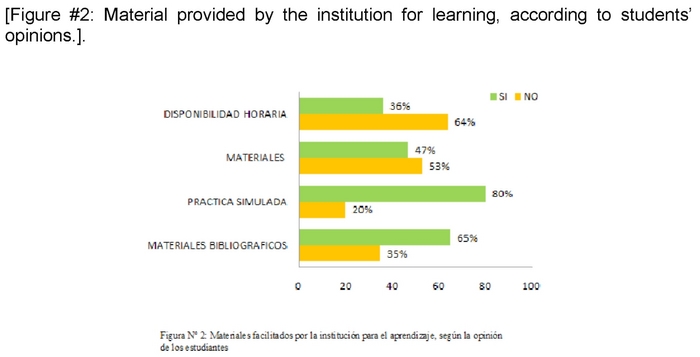
In the variable facilities, 57% of the students answered that the place is not appropriate as regards classrooms, study areas and offices. The availability of a library is identified as highly positive in 79% of cases, as well as lighting in 58%.
Students state that they get support in different pedagogic variables: in more than 75% of cases, through couching, counsel and educational psychologist office in the first place, and in 53% of cases from teacher availability. The access to bibliographic material suggested by teachers and offered in a printed version is considered positive by 75% of the students.
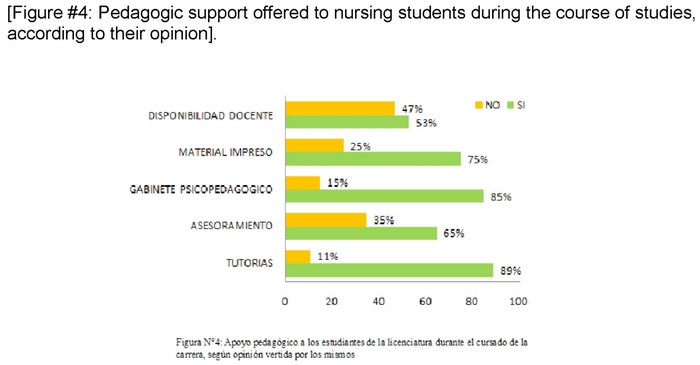
With respect to procedures to present complaints, 75% answered that their claims are not taken into account by the directors, in the second place, 63% said their complaints are not listened to by the administrative and technical staff and 44% considered teachers do not take them into account. The place where they consider their complaints and claims are best listened to is the students' union.
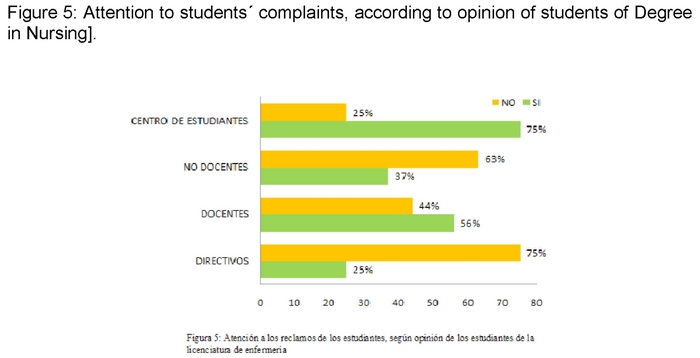
In chair planning, students answered in 78% of cases that it does not exist, explaining that there is no special planning according to students' needs, and 66% said it does not allow the planning of daily life and has a negative impact on each student's personal life.

Fifty-two percent of the surveyed students answered that during the period studied there was no ability in management.
Regarding the academic bonding aspect, students do not feel listened to in the institution in 65% of cases; they answered that communication among peers is little or not very cooperative in 59%. Seventy-eight percent of students say there is no communication between the two cycles of the course of studies Degree in Nursing.
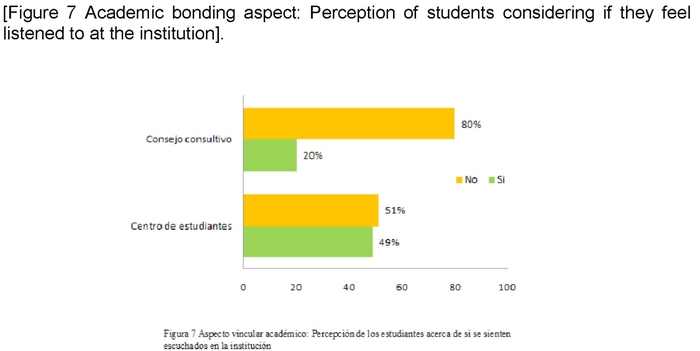
In the last place, in the dimension student participation, most students, 92 %, say they do not participate in an active way in the students' union, and 59% of students state that the promotion of a healthy setting is not included among the students' union activities.
Discussion
In two studies carried out at National Universities, one of them at local level, results referring to the demographic characteristics of this research do not differentiate significantly from the general results in the Public University setting. In them, the prevalence of women and of the age group between 20 and 30 are confirmed. 22 23.
The percentage of students with scholarship benefits is explained through the policy of incentive to the course of studies, at national and provincial level, in order to reduce the existing shortfall between graduated nurses and the increased demand in the labor market24.
Regarding the dimension organization and management, they are negatively identified in structural aspects such as facilities or timetables, and also in the dynamic aspects of academic organization. As for the first ones, it can be said that the difficulties indicated with respect to the facilities are connected with the history of the school of nursing, given that the place where it operates is the same since it was founded and has not expanded, although the number of students has increased.
Another finding of this research, with negative influence in educational settings, is the use of classrooms shared with students from other courses of studies, situated in different places within the university campus. This fact is considered in other studies carried out in Spain and Costa Rica as a potential risk factor since it implies the movement of students in different places which not always match the availability of back up services in that setting, as may be the library or the lab for simulated practices. These characteristics, belonging to the studied institution, mean a reduction of useful time because of the movement implied 25
Different authors say that structural aspects of an organization can be made more flexible to allow dynamic processes more consistent with users' demands and social context. Thus, the pedagogic impact and the availability of materials students consider highly positive would be maximized. The mentioned authors also add to the discussion, the role of staff, in this case, teachers and non academic staff, in their bureaucratic relationship with the state and their participation in the continuity and innovation of policies. In this sense, the teaching roles or the non academic roles allow or not, the management of processes that bring the university close to citizen's demands. 26 27 28 2910 31
It is observed that the need to make the internal dynamic of the school of nursing more flexible and to create healthy educational settings is not an institutional policy going across different faculties. The Latin-American experiences, already mentioned in Costa Rica and Colombia, may be a transformation basis at the studied institution.
These aspects are related to the academic bonding dimension, not only because they condition each other but also because they generate similar visions regarding the communication factor, among peers and in the relationship with teachers or with other faculties, which shows difficulties.
As regards the dimension of students' participation, the date referring to communication and participation in the same institution are weak in the different university areas. They are related to findings from other studies expressing that the post modern social processes have weak social bonds and citizens' participation is mainly delegative. The strengthening of participation mechanisms does not imply at all the weakening of the representation institutions; on the contrary, it involves their simultaneous strengthening.32
Conclusions
As regards the general characteristics of the student group, we conclude that the composition is not different from the general university and the history of the course of studies.
With respect to the educational setting, especially the dimension organization and management, we identify the need to improve management and organization to bring the school close to healthy setting parameters, considering that there are highly positive aspects such as teachers' support in their different pedagogic methodologies.
In the dimensions academic bonding and student participation, both are weak in different university areas.
Possibly, they are not considered as an educational priority; it is necessary to develop elements to observe this problem as a central one in the policy of academic management in order to create joint resolution strategies.
Received: May 9, 2014
Accepted: 11 June 2014
References
1. Consejo Internacional de Enfermeras (CIE). Entornos de práctica favorables: lugares de trabajo de calidad = atención de calidad al paciente. Ginebra - Suiza 2007. (Acceso marzo 2014) Disponible en: http://www.icn.ch/images/stories/documents/publications/ind/indkit2007sp.pdf. [ Links ]
2. Ministerio de Protección social Ministerio de Ambiente, Vivienda y Desarrollo territorial; ops/Colombia. Entornos saludables: Guía del Docente. Bogotá. 2006. (Acceso marzo 2014) Disponible en: http://www.bvsde.paho.org/bvsdeescuelas/fulltext/entornosdocente/presenta.pdf. [ Links ]
3. Casas SB, Klijn TP. Promoción de la salud y su entorno laboral saludable. Rev Latinoamericana Enfermagem 2006 janeiro-fevereiro; 14(1):136- 41. (Acceso marzo 2014) Disponible en: http://www.eerp.usp.br/rlae. [ Links ]
4. Organización Panamericana de la Salud. Organización Mundial de la Salud. División de Salud y Ambiente. Programa Regional de Salud de los Trabajadores. Documento de Trabajo. Anexo No 6: Estrategia de Promoción de la salud en los lugares de trabajo de América Latina y el Caribe. San José, Costa Rica, Marzo 15 a 17 de 2000. (Acceso marzo 2014) Disponible en: http://www.who.int/occupational_health/regions/en/oehpromocionsalud.pdf. [ Links ]
5. Organización Panamericana de la Salud. Metas Regionales en Materia de Recursos Humanos para la Salud 2007-2015. 27 Conferencia sanitaria Panamericana, 59 Sesión del Comité Regional de la OMS para las Américas. 2007. WDC.(Acceso en Marzo 2014) Disponible en: http://www.paho.org/sapanich/gov/.pdf. [ Links ]
6. Aiken L., Clarke S., Sloane D., Soalski J., Silber J. Enfermera del hospital Dotación y mortalidad de los pacientes, la enfermera de la quemadura, y la insatisfacción laboral. JAMA 2002; 288 (16) :1987-1993. doi: 10.1001/jama.288.16.1987. (Acceso marzo 2014) Disponible en: http://¡ama.¡amanetwork.com/article.aspx?articleid=195438. [ Links ]
7. OPS/OMS, Boletín No. 5 de la Red Colombiana de Escuelas Saludables por la Paz. (Acceso marzo 2014) Disponible en: http://www.minproteccionsocial.gov.co/ entornoambiental/library/documents/DocNewsNo15493DocumentNo3280.pdf. [ Links ]
8. Giraldo Osorio A., Toro Rosero M.Y., Macías Ladino A.M., Valencia Garcés C. A., Palacio Rodríguez S. La promoción de la salud como estrategia para el fomento de estilos de vida saludables. Volumen 15, No.1, enero-junio 2010, págs. 128-143. (Acceso marzo 2014) Disponible en http://promocionsalud.ucaldas.edu.co/downloads/Revistas15(1)_9.pdf. [ Links ]
13. Lozano Díaz A. Factores personales, familiares y académicos que afectan al fracaso escolar en la educación secundaria. Almería, España. 2003. Revistra welectrónica de investigación psicoieducativa y psicopedagógica, 1(1),43-66. (Acceso marzo 2014) Disponible en www.investigacion-psicopedagogica.org/revista/articulos/1espannol/ Art_1_4.pdf. [ Links ]
14. Robledo Ramón P. y García Sánchez J.N. El entorno familiar y su influencia en el rendimiento académico de los alumnos con dificultades de aprendizaje: revisión de estudios empíricos. Aula abierta 2009, vol 37, no 1, pp 117-128, ICE. Universidad de Oviedo.Espana. (Acceso en marzo 2014) Disponible en: http://www.minproteccionsocial.gov.co/entornoambiental/library/documents/DocNewsNo15493DocumentNo3280.pdf. [ Links ]
15. Garbanzo Vargas G.M. Factores asociados al rendimiento académico en estudiantes universitarios, una reflexión desde la calidad de la educación superior pública. Revista Educación 31(1), 43-63. 2007. (Acceso en marzo 2014) Disponible en: http://latindex.ucr.ac.cr/index.php/educacion/article/viewFile/1252/1315. [ Links ]
16. Marchesi A., Martinez R., Matin E. Estudio longitudinal sobre la influencia del nivel socio cultural en el aprendizaje de los alumnos en la educación secundaria obligatoria. Infancia y aprendizaje. 2004. 27(3), 307-323. [ Links ]
17. Beguet, Bernardo. Factores que intervienen en el rendimiento académico de los estudiantes de psicología y psicopedagogía. Universidad de El Salvador. [ Links ]
18. Herrera Batista, M.A. Las Nuevas Tecnologías en el Aprendizaje Constructivo. Universidad Autónoma Metropolitana, México. La Revista Iberoamericana de Educación. Numero 34/4. (Acceso en marzo 2014) Disponible en: http://www.rieoei.org/deloslectores/821 Herrera.PDF. [ Links ]
19. Marino S. I. y Godoy M. V. Desarrollo de entornos virtuales educativos. Contribuciones desde el Área de Ingeniería Web. Revista electrónica, Quaderns Digitals/Quaderns número 53. (Acceso en marzo 2014) Disponible en: http://www.quadernsdigitals.net/index.php?accionMenu=hemeroteca.VisualizaArticuloI U.visualiza&articulo_id=10492. [ Links ]
20. Di Gresia L., Porto A. y Ripani L. Rendimiento de los Estudiantes de las Universidades Públicas Argentinas Documento de Trabajo Nro. 45. Noviembre 2002. Departamento de Estadísticas. Facultad de Ciencias Económicas. Universidad Nacional de la Plata. (Acceso en marzo) Disponible en: http://www.depeco.econo.unlp.edu.ar/doctrab/doc45.pdf. [ Links ]
21. Goldenhersch H., Llinás G., Balzarini M., Maccagno A., Somazzi C., Esbry N. Espacio Iberoamericano del Conocimiento. Dos siglos de graduaciones en la UNC registros históricos y experiencias del presente. Secretaría de Asuntos Académicos -Programa de Estadísticas Universitarias. Universidad Nacional de Córdoba, 2010. (Acceso en marzo) Disponible en: http://www.chubut.edu.ar/descargas/secundaria/congreso/EIC/R0327%Maccagno.pdf. [ Links ]
22. Ministerio de Salud. Presidencia de la Nación. Proyecto De Ley de Emergencia de Enfermería Consejo Federal de Salud. 12 de Setiembre de 2008. (Acceso en Marzo 2014) Disponible en: http://www.msal.gov.ar/images/stories/cofesa/2008/acta-03-08/anexo-12-03-08.pdf. [ Links ]
23. Machado Alba, J. E. La Universidad Saludable. Revista de Ciencias humanas No 16, Julio de 2001. (Acceso 4 de marzo de 2014) Disponible en: http://www.utp.edu.co/~chumanas/revistas/revistas/rev26/machado.htm. [ Links ]
24. Mintzberg, H. Diseño de organizaciones eficientes. Cátedra Administración gerencial. UTN-FRSFD. 2001. (Acceso marzo de 2014) Disponible en: file:///C:/Users/saludpublica/Downloads/Apunte Dise%C3%B1oOrganiz Final.pdf. [ Links ]
25. Hintze, J. Administración de Estructuras Organizativas. Revista trasformación, estado y democracia 37. 67-106 (Acceso en febrero 2011) Disponible en: http://www.onsc.gub.uy/onsc1/images/stories/Publicaciones/RevistaONSC/r37/37-8.pdf. [ Links ]
26. Hammer, M. y Stanton, S. La Revolución de la reingeniería Reingeniería. Ediciones Díaz de Santos, 1997-384 páginas. [ Links ]
27. Universidad de Alicante. Red española de universidades saludables (REUS). La universidad de Alicante: Una Universidad saludable.2008. (Acceso en Marzo 2014) Disponible en: http://web.ua.es/es/sep/documentos/pdf/ua/red-espanola-de-universidades-saludables.pdf. [ Links ]
28. Hintze, J. Gestión por procesos y por resultado en el aparato estatal; una cuestión abierta. Ponencia presentada en el Segundo Congreso Argentino de Administración Publica. 2003. República Argentina. (acceso marzo de 2014) Disponible en: http://issuu.com/asap1/docs/gestionporprocesosyresultados?e=3399398/2439275#search. [ Links ]
29. Carvalho R.S, Viana L, La formación del enfermero en las escuelas de enseñanza media desde un concepto de interdisciplinariedad. Vol 8, Núm 1 (2009) (Acceso 15 Febrero 2014) Disponible en http://revistas.um.es/eglobal/article/view/49812/47692. [ Links ]
30. Ase, I. El futuro de la modernización administrativa del estado: de la ilusión tecnocrática a la reconstrucción de lo público. Segundo Congreso Argentino de Administración Pública. Sociedad, Estado y Administración. 2002. (Acceso en marzo de 2014) Disponible en: http://aaeap.org.ar/wp-content/uploads/2013/03/AseIvan.pdf. [ Links ]











 texto em
texto em 

